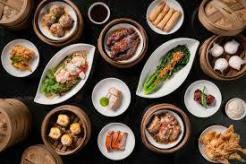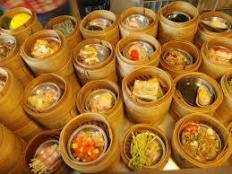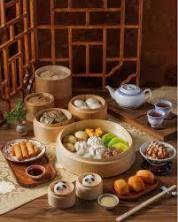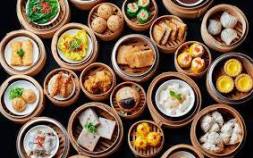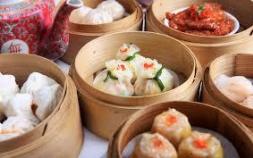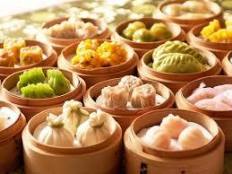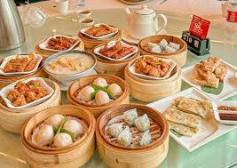the Delight of Dim Sum
Introduction to Dim Sum: A Cultural and Culinary Heritage
Dim sum is a cherished tradition within Chinese cuisine, encompassing a diverse array of bite-sized dishes that are typically served in small portions. The origins of dim sum can be traced back to the southern regions of China, particularly Canton, around the 10th century. Initially served as a snack for travelers along the Silk Road, dim sum evolved into a significant dining experience, particularly in the bustling teahouses of Guangdong province. These small dishes not only reflect regional culinary styles but also embody the vibrant social aspect of dining in Chinese culture.
The cultural significance of dim sum extends beyond mere sustenance; it is a ritual steeped in history and communal bonds. Families and friends gather to enjoy this dining experience, often partaking in the traditional practice of "yum cha," which translates to "drinking tea." Yum cha is not only an occasion to savor delectable offerings but also serves as a social gathering where relationships are nurtured and stories are shared. The act of selecting various dim sum dishes, from steamed buns to delicate dumplings, promotes a sense of community, as diners are encouraged to share and sample each other's selections.
Dim sum is distinguished by its numerous regional variations, each showcasing unique ingredients and cooking techniques. For instance, Hong Kong-style dim sum is renowned for its finesse, featuring fine craftsmanship and an array of flavors. In contrast, northern styles may incorporate different doughs and fillings. These regional distinctions offer diners a chance to experience a rich tapestry of flavors and textures, reinforcing the overarching cultural heritage tied to this culinary tradition. Through its communal dining experience, delectable offerings, and regional diversity, dim sum stands as a testament to the enduring legacy of Chinese gastronomy.
Dipping into Japan: A Shabu-Shabu Culinary TripCatwalk
Discover the delightful experience of shabu-shabu, a traditional Japanese hot pot dish that emphasizes high-quality ingredients and communal dining. Learn about its origins, essential components, and the unique cooking methods that create a rich culinary experience. Delve into the culture surrounding shabu-shabu, from the types of meats and vegetables used to the importance of social interaction during meals. Join in the tradition of enjoying shabu-shabu with friends and family, and explore how this beloved dish embodies the essence of Japanese cuisine.
The Ultimate Donburi Experience
Explore the delicious world of donburi, a comforting Japanese rice bowl dish that offers endless versatility. Discover traditional variations like Gyudon and Katsudon, learn how to prepare the perfect short-grain rice, and experiment with an array of toppings that can enhance flavors. From succulent proteins to fresh vegetables and flavorful sauces, create your own donburi masterpiece at home. This guide celebrates both the rich culinary tradition of Japan and the modern fusion variations that have emerged worldwide, making donburi a favorite for food lovers everywhere.
Dive into the delights of Shabu-Shabu
Discover the delightful world of shabu-shabu, a traditional Japanese hotpot dish that emphasizes freshness and communal cooking. Learn about its origins, essential ingredients like premium beef and seasonal vegetables, and how to recreate this interactive dining experience at home. From making the perfect broth to choosing the best dipping sauces, explore everything you need to know to enjoy shabu-shabu with family and friends, transforming your meal into a memorable culinary adventure.
A Steamy Adventure
Discover the delightful world of Shabu-Shabu, a traditional Japanese hot pot dish that emphasizes communal dining. Learn about its origins, essential ingredients like high-quality beef and fresh vegetables, and step-by-step cooking instructions. Explore pairing suggestions with beverages and side dishes to enhance your dining experience. Shabu-Shabu is not just a meal but a cultural experience where friends and family come together to enjoy delectable flavors while making lasting memories. Elevate your culinary skills with this comprehensive guide to Shabu-Shabu!
Gastronomic Getaway: Discovering Authentic Japanese Dishes
Introduction to Japanese Cuisine
Japanese cuisine, known for its artful presentation and ability to harmonize flavors, embodies a deep cultural heritage that emphasizes freshness, seasonality, and umami. One of the fundamental principles of Japanese cooking is the concept of “shun,” which refers to utilizing ingredients at the peak of their flavor. This ensures that each dish not only satisfies the palate but also reflects the beauty of nature in its changing seasons.
The intricate culinary landscape of Japan consists of a variety of regional cuisines, influenced by local ingredients and traditions, thus creating a rich tapestry of flavors and techniques. For instance, while sushi is celebrated worldwide, its preparation often varies extensively across different prefectures, from the vinegared rice used in Edo-style sushi to the unique toppings served in Kansai. Ramen, with its heartwarming broths and diverse toppings, serves as another perfect example of regional adaptations, illustrating how even a single dish can be reinterpreted endlessly.
Traditional Japanese food does not solely rely on taste; aesthetic presentation plays a crucial role in the dining culinary experience. Meals emphasize visual appeal, with colorful arrangements and the use of seasonal tableware, enhancing the enjoyment of each dish. The balance between taste and beauty demonstrates the respect for nature ingrained in Japanese culture.
Moreover, exploring Japanese cuisine introduces various lesser-known delicacies that reflect local customs and available ingredients. From succulent grilled skewers called yakitori to delicate sweets known as wagashi, each bite opens a doorway to the rich history and cultural identity of Japan. As we embark on this gastronomic journey, anticipation builds for an exploration of authentic Japanese dishes that showcase the depth and diversity of this remarkable culinary tradition.
Must-Try Authentic Japanese Dishes
Japanese cuisine is renowned for its rich flavors, meticulous presentation, and diverse ingredients. To truly appreciate the culinary art of Japan, one should indulge in a selection of must-try authentic Japanese dishes that highlight both simplicity and complexity. Among these, sushi stands as perhaps the most iconic. Made from vinegared rice combined with a variety of ingredients, including seafood, vegetables, and sometimes tropical fruits, sushi varies from region to region. From the delicate nigiri, which features a slice of fish atop a small mound of rice, to the rolled maki, which can incorporate a plethora of fillings, enjoying sushi is essential to experiencing Japanese food culture.
Another dish that embodies the essence of Japan is ramen. This hearty noodle soup comes in several regional varieties, each boasting unique broths, noodles, and toppings. Common ramen styles include shoyu (soy sauce), miso, and tonkotsu (pork bone), each providing a distinct flavor profile. The preparation of ramen is an art form, where chefs often spend years perfecting their recipes. To enjoy an authentic bowl of ramen, one should visit a specialized ramen shop, where the atmosphere complements the culinary experience.
Okonomiyaki is yet another dish that captivates with its versatility and flavor. Often referred to as a "Japanese savory pancake," this dish is made with a batter containing shredded cabbage, meat, seafood, and topped with mayonnaise and a special sauce. Originating from Hiroshima and Osaka, the preparation methods vary, leading to different styles of okonomiyaki. It is a dish that encourages customization and shared culinary experiences, making it a favorite among locals and visitors alike.
Lastly, one cannot overlook tonkatsu, which is breaded and deep-fried pork cutlet. Typically served with shredded cabbage and a tangy sauce, this dish epitomizes comfort food in Japan. The crispy exterior combined with tender meat creates a delightful textural contrast. Whether enjoyed in a casual diner or a more upscale establishment, tonkatsu represents the heart of Japanese home cooking.
In conclusion, exploring these must-try authentic Japanese dishes provides a glimpse into the cultural and culinary diversity that Japan offers. By experiencing sushi, ramen, okonomiyaki, and tonkatsu, one not only experiences unique flavors but also engages with traditions that have been cherished for generations.
Culinary Experiences and Locations to Visit
Japan, known for its rich culinary heritage, offers a multitude of experiences where travelers can indulge in authentic Japanese dishes. From traditional establishments to bustling street corners, the diversity of food options is astounding. One of the best ways to experience Japanese cuisine is by visiting local izakayas, which are casual pubs offering a wide variety of dishes and drinks. These establishments often emphasize seasonal ingredients and traditional cooking methods, providing an intimate dining culinary experience.
For a truly immersive culinary journey, food markets like Tsukiji in Tokyo and Nishiki in Kyoto are must-visit locations. At Tsukiji, visitors can witness the hustle and bustle of Japan’s seafood trade, while sampling freshly prepared sushi and sashimi. Nishiki Market, on the other hand, is renowned for its array of local specialties such as yuba (tofu skin), mochi, and pickles. Both markets showcase the vibrant food culture that defines Japan.
Street food is another significant aspect of Japan's culinary landscape. Areas such as Dotonbori in Osaka and Namba in Tokyo feature an array of vendors selling takoyaki (octopus balls), okonomiyaki (savory pancakes), and yakitori (grilled skewers). These dishes not only tantalize the taste buds but also reflect the unique regional flavors present throughout the country.
For those who wish to dig deeper into Japanese cooking, enrolling in cooking classes can provide hands-on experience. Many establishments offer lessons covering various aspects of Japanese cuisine, from sushi making to traditional tea ceremonies. Moreover, guided food tours allow travelers to explore multiple culinary hotspots while learning about the history and culture behind each dish. Participating in local food festivals and cultural events, such as the Tokyo Sake Festival or Kyoto’s Gion Matsuri, can further enrich one's gastronomic adventure, showcasing food in its cultural context.
Tips for Enjoying Japanese Food Culture
To fully immerse oneself in Japanese food culture, it is essential to understand both the dining etiquette and the aesthetics that accompany the cuisine. One of the first aspects to consider is the importance of presentation. Japanese dishes are meticulously arranged, and the visual appeal plays a significant role in the dining experience. Traditional serving ware, such as lacquered bowls and ceramic dishes, not only enhances the meal’s aesthetic but also reflects the season and the cultural importance of the food served.
When dining in Japan, it is important to follow specific etiquette. For example, it is customary to say "itadakimasu" before starting a meal and "gochisousama deshita" upon finishing. This practice expresses gratitude for the food and the effort that went into its preparation. Additionally, using chopsticks properly is crucial. Avoid sticking chopsticks upright in rice, as it resembles a funeral rite. Instead, place them on the designated holder when not in use.
Balancing flavors is another hallmark of Japanese cuisine. Meals typically feature a combination of sweet, sour, salty, and umami tastes, each complementing the others to create a harmonious experience. Opting for seasonal ingredients enhances this balance, as they tend to offer the freshest flavors. In Japan, local specialties, such as Kyoto's yudofu or Hokkaido's seafood, highlight regional culinary traditions and ensure that diners enjoy the best of what the season has to offer.
Finally, no discussion of Japanese food culture would be complete without mentioning the art of matcha tea preparation. The tea ceremony exemplifies the zen-like appreciation of food, where ritualistic elements contribute to the overall culinary experience. Observing traditional customs and practices strengthens one's connection to the meal and enriches understanding of Japanese culinary heritage. With these insights, one can truly enjoy the unique and profound elements of Japanese food culture.
